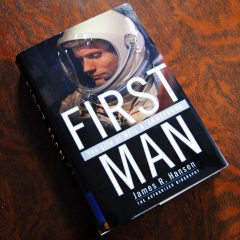
I have always been fascinated with Space. I’ve said this before when I wrote about building my LEGO Saturn V Rocket, that I had wanted to grow up to be an aerospace engineer. It’s a fascination that has remained despite my educational leanings towards the liberal arts and away from the sciences.
So when I heard that coming this October there would be a movie release called “First Man” a biopic about Neil Armstrong, based on the authorized biography of the same name. I decided to pick up the book first and get more of the picture than could possibly be summed up in a sub-two-hour movie, which isn’t much more than the 2 hours, 31 minutes and 40 seconds that Neil was on the surface of the moonwalking around.
The book is a brilliant combination of biography and technical history lesson into the NASA as told along the way from one of NASA’s, and it’s preeminent predecessor NACA’s, shining stars: Neil A. Armstrong.
So, here are my 11 takeaways from the book, because why not 11, it was the Apollo mission that successfully put man on the moon.
1. CBS Correspondent Eric Sevareid had his finger on the pulse during the launch of Apollo 11
Shortly before liftoff, CBS News commentator Eric Sevareid, who at age sixty-six was seeing his first manned shot, described the scene to Walter Cronkite’s television audience: “Walter… as we sit here today… I think the [English] language is being altered…. How do you say ‘high as the sky’ anymore, or ‘the sky is the limit’–what does that mean?”
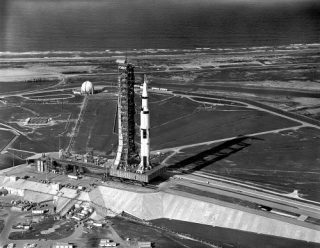
With those two observations, Sevareid did an amazing job summing up the moment, while within the moment. Surely, you could come to these conclusions in hindsight, but to have been able to do it in the moments leading up to liftoff was truly a wonderful addition to the many glued to their televisions during “a shared global event which nearly all humankind felt transcended politics.”
2. Armstrong fell in love with flight
While he had yet to become an astronaut, or even an engineer when he first became a pilot, he knew he was enamored with flight.

Neil Armstrong
For Neil, however, this new era in flight dawned bittersweet. “By the time I was old enough and became a pilot, things had changed. The great airplanes I had so revered as a boy were disappearing. I had grown up admiring what I perceived to be the chivalry of the World War I pilots–Frank Luke, Eddie Rickenbacker, Manfred von Richthofen, and Billy Bishop. But by World War II, aerial chivalry seemed to have evaporated….Air warfare was becoming very impersonal. The record-setting flights–[John] Alcock and [A. W.] Brown, [Harold] Gatty, [Charles] Lindbergh, [Amelia] Earhart, and [Jimmy] Mattern–across the oceans, over the poles, and to the corners of Earth, had all been accomplished. And I resented that. All in all, for someone who was immersed in, fascinated by, and dedicated to flight, I was disappointed by the wrinkle in history that had brought me along one generation late. I had missed all the great times and adventures in flight.”
And while, looking back, we know he made one of the most significant flights in human history, growing up, he felt as if he had missed the boat. And while he might have, in respect to flight achievements here on Earth, he still partook in the one flight he wasn’t thinking of at that time.
3. Engineer First, First Engineer
For the rest of his life, engineering would be Armstrong’s primary professional identity. Even during his years as a test pilot and as an astronaut, Neil considered himself first and foremost an aeronautical engineer, one whose ambition to write an engineering textbook set him apart from virtually all of his fellow fliers. It is only in this context that one can truly understand a statement that a frustrated Armstrong would make to a Cincinnati newspaper reporter in 1976: “How long must it take before I cease to be known as a spaceman?”
Two of the most important–and rarely acknowledged–points about the Apollo lunar landing program are that it was engineering–much more than science–that accomplished the moon landing, and that an engineer, not a scientist, was the first to set foot on another world.
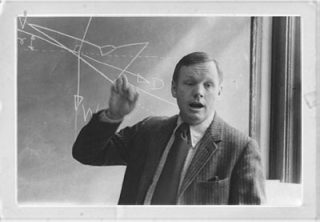
Professor Armstrong teaching Engineering
And it was important to Armstrong that people know he was an engineer. “I am, and ever will be, a white-socks, pocket-protector nerdy engineer. And I take substantial pride in the accomplishments of my profession.”
His profession explored the limits, because as Neil says, “Science is about what is; engineering is about what can be.” So what could be more fitting than an engineer being the First Man on the Moon “proving the adage that it was much easier to make a pilot out of an engineer than it was to make an engineer out of a pilot.”
And after it was all said and done, he still just wanted to do what engineers do when they’ve moved on into the twilights of their careers, he wanted to teach. “I had had a lot of university invitations by this point but most of them–far and away the majority of them–were invitations to be considered for university presidencies. I just wanted to be a professor.”
4. Unwanted Celebrity for an Introvert
They say “no man is an island”; well, Neil is kind of an island. . . . Sometimes what he was thinking and his inner thoughts were more interesting to him than somebody else’s thoughts were to him, so why should he leave his island, go wading out into the shallows to shake hands with somebody, when he’s perfectly happy back in his little grass hut or wherever.
-Michael Collins, Gemini X, and Apollo 11 Astronaut

Neil Armstrong portrait from 1959
And that quote is all the more prescient in understanding how meaningful Jim Lovell’s statement to Apollo 11 just prior to reentry was, when he said, “Backup crew is still standing by. I just want to remind you that the most difficult part of your mission is going to be after recovery.”
To that end, “The high price of celebrity was a heavy burden that all of the early astronauts and their families had to pay, but none more dearly than the First Man–as personally unwanted as his status as a celebrity and global icon particularly was. It was an unwanted, unasked for, but inevitable, legacy that Armstrong shared with his hero, Lindbergh.”
And Armstrong had a hard time being recognized above his actual achievement, “I think that people should be recognized for their achievements and the value that adds to society’s progress. But it can be easily overdone. I think highly of many people and their accomplishments, but I don’t believe that that should be paramount over the actual achievements themselves. Celebrity shouldn’t supersede the things they’ve accomplished.”
In becoming a bit reclusive as a celebrity, “Armstrong, because he was so hard to know, turned out to be myth personified, an enigma prime to be filled with meaning.”
5. Aldrin or Lovell
Reading this paragraph was like having the “butterfly effect” explode in my brain.

Gemini 12 Aldrin and Lovell
“Deke laid out his thinking about Apollo 11 and asked how I felt about having Mike Collins and Buzz Aldrin as my crew. We talked about it a little bit, and I didn‘t have any problem with that. And Deke said that Buzz wasn’t necessarily so easy to work with, and I said, ‘Well, I’ve been working with him the last few months [in the backup role for Apollo 8] and everything seems to be going all right.’ But I knew what Deke was saying. Then he said he wanted to make Jim Lovell available for Apollo 11 even though it would be a little bit out of sequence, but that’s what he’d do, if that is what I thought I needed. I would have been happy to get Lovell. Jim was a very reliable guy, very steady. I had a lot of confidence in him. It would have been highly unusual for the crew assignment to have worked out this way but Deke offered the possibility that it would be Jim Lovell and Mike Collins as my crew.”
While Armstrong eventually stayed within the original crew assignment, because Lovell deserved his own command, it’s hard to read that paragraph and not think about Aldrin being on Apollo 13, if it had worked out that way. Perhaps it would have changed the outcome, perhaps not, but just the “what if” is too great not to mention.
6. Amiable Strangers
Mike Collins coined the phrase to describe the crew of Apollo 11 made up of Armstrong, Aldrin, and himself, but Guenter Wendt, gives an outsider’s perspective into that description.
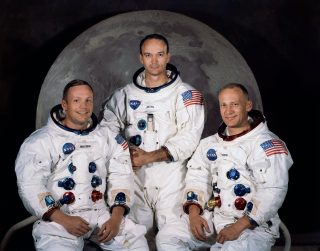
Apollo 11 Crew: Armstrong, Collins, and Aldrin
“There was a hell of a difference between those three men,” said Guenter Wendt, the head of the White Room Crew at the Cape. As the chief technician responsible for the final sealing of the astronauts into their capsule, Wendt (nicknamed “The Launchpad Führer” for his German accent and Teutonic exactness) saw all the Apollo crews in action over the course of many training and launch days, and he never saw anything like the crew of Apollo 11. “Although they were totally competent, they just didn’t seem to gel as a team. Usually when a mission crew was named, they stuck together like glue. You saw one, you saw all three, together. But these three, they never did. When they drove up to the pad for tests, it was always in three separate cars. If we broke for lunch, they always drove away separately. There did not seem to be much camaraderie between the three men. I’ve always said that they were the first crew who weren’t really a crew.”
And yet, despite the apt description, they did what they set out to do.
7. Why Neil?
Chris Kraft, Bob Gilruth, Deke Slayton, and George Low had a secret meeting to determine who would be the First Man to set foot upon another celestial body.
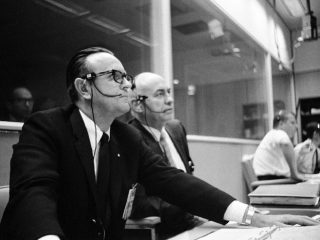
Kraft and Gilruth
“Neil was Neil. Calm, quiet, and absolute confidence. We all knew that he was the Lindbergh type. He had no ego. He was not of that mind that, ‘Hey, I’m going to be the first man on the Moon!’ That was never what Neil had in his head. The most Neil had ever said about it might have been that he wanted to be the first test pilot on the Moon or the first flier to land on the Moon. If you would have said to him, ‘You are going to be the most famous human being on Earth for the rest of your life,’ he would have answered. ‘Then I don’t want to be the first man on the Moon.’ But he probably knew it was his obligation to do so. On the other hand, Aldrin desperately wanted the honor and wasn’t quiet in letting it be known. Neil had said nothing. It wasn’t his nature to push himself into any spotlight. He was much like Bob Gilruth himself, content to do the job and then go home.
“Not once did we criticize Buzz for his strongly held positions or for his ambition. The unspoken feeling was that we admired him and that we wanted people to speak their mind. But did we think Buzz was the man who would be our best representative to the world, the man who would be legend? We didn’t. We had two men to choose from, and Neil Armstrong, reticent, soft-spoken, and heroic, was our only choice.
And while history has judged them to be correct, more or less, in their decision, you can’t find fault with their reasonings.
8. Michael Crichton Impacted the Pre-launch Procedures of Apollo 11

The Andromeda Strain by Michael Crichton
Wait, what? Yes, it’s absolutely true.
“Besides checking on their health (Dr. Berry reported to the press that the crew was ‘in excellent physical shape’ and looked ‘amazingly relaxed’), the doctor wanted to catalog all organisms that were apparently normal to the three men’s systems. A growing fear from the scientific community that hostile, alien organisms might accompany the astronauts and their rock samples back to Earth–a concern hyped by the publication of the sensational Michael Crichton novel The Andromeda Strain, a June 1969 Book-of-the-Month Club selection–had persuaded (even forced) NASA to take every possible preventative measure against contamination from extraterrestrial life.”
Besides, there may have been a lot about getting to the Moon that NASA knew, and even more, they knew in theory, but there was still a ton they could not know, and most of it was unknown and out of reach even if they knew what it was.
9. Of a Fire on the Moon
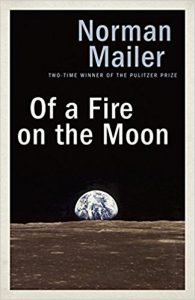
Of a Fire on the Moon by Norman Mailer
While Norman Mailer was as captivated as everyone else by the Moonshot of Apollo 11, he was equally enthralled with the enigma that was it’s Commander, Neil Armstrong.
Armstrong had mastered “computerese.” Instead of saying “we,” Neil convoluted the English language and said, “A joint exercise has demonstrated.” Instead of saying “other choices,” her referred to “peripheral secondary objectives.” Rather than “doing our best,” it was “obtaining maximum advantage possible.” To “turn on” and “turn off” became “enable” and “disable.” Mailer, who had rejected in disgust his own college education as an engineer, saw in Neil’s vernacular proof not only that “the more natural forms of English had not been built for the computer” but that Armstrong represented “either the end of the old or the first of the new men.”
And you can read all of Mailer’s pieces for Life magazine which was serialized into a book published as Of a Fire on the Moon.
10. Coming down is the hardest thing
As the late Tom Petty sang in his hit Learning to Fly, “coming down is the hardest thing.”
Indeed, going back all the way to his boyhood fall from a backyard tree, most of the high drama in Armstrong’s life lay more in his “comings down” than his “goings up.” Not that his ascents did not take extreme concentration and skill. Still, it was the descents that ultimately posed the greatest challenge and danger–and defined his destiny.
11. Pushing Forward
Even after his time on the Moon, Armstrong continued to push mankind forward. In many of his speeches, he emphasized the need to keep discovering.
“The need to build a new world is what lifts man’s horizons in search of the future. Without these horizons, a man turns inward and is concerned only with himself. With them, he thinks more about tomorrow than today, more about society than himself.”
“Human character. This is the area where we’ve made the least progress–learning about the brain, about our behavior and the ways we relate to one another. I think that’s the most important direction we can take in the next twenty years, basically to begin to understand ourselves.”

Neil Armstrong Commencement Speech at USC
“We know the advancement of knowledge and the rate of progress is proportional to the risk encountered. . . . The success of the endeavor will also be dependent on the degrees to which the aerospace community, government, industry, and academia can coalesce their forces and converge on a common goal.”
But he didn’t go on to say that we should just move forward without thinking. “One of the consistent themes in Neil’s presentations is ‘junk science,’ how a small amount of knowledge can be a dangerous thing, and how society should not draw a sweeping conclusion when knowledge about a subject is noticeably incomplete.”
And “to his credit, he often humorously related, ‘the future is not something I know a great deal about. But I did live in Washington for a time and learned that lack of knowledge about a subject is no impediment to talking about it.’”
Post List Debriefing
This book explores not only the life of the First Man on the Moon but also the life of a lifelong engineer who was not afraid to be himself. He could be humorous, as “When asked how he prefers for historians to quote his statement, Neil answers only somewhat facetiously, ‘They can put it in parentheses.’”
Well, Neil, this one is for you. (That’s one small step for man, one giant leap for mankind.)
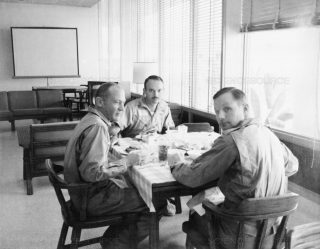
Apollo 11 Postflight Debriefing
As for the NASA historical stories that go along with Neil’s life, those are also not without humor. I mean, after traveling to the Moon and back, the astronauts in quarantine for 21 days after their return had this happen.
Near the end of their stay, each astronaut, as federal government employees, was asked to fill out an expense report for their flight to the Moon. Filled out for them to sign, the forms read: “From Houston, Tex., to Cape Kennedy, Fla., to the Moon, to the Pacific Ocean to Hawaii and return to Houston, Tex.” The astronauts had traveled by “Government Aircraft, Government Spacecraft, USN Hornet, USAF Plane.” Their total reimbursement was for $33.31.
It seems that the government may have shortchanged them a bit. But all in all, this book, First Man by James R. Hansen is brilliant as an authorized biography not co-written in any way by its subject. As such, I will agree with Hansen, who wrote in his acknowledgments, “The result, I believe, is an exceptionally rare type of book: an authorized biography more candid, honest, and unvarnished than most unauthorized biographies.”
Go out and get your hands on First Man by James R. Hansen. The movie will not explore in detail all of the stories that this book expresses. So, go to your local bookstore, library or online bookstore of choice. You won’t be let down.